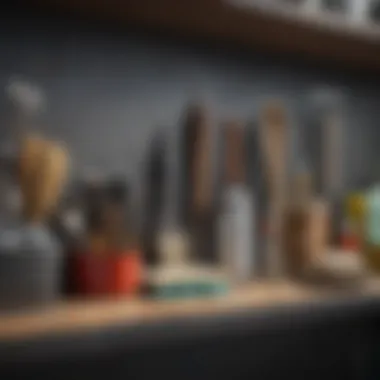Monthly Home Cleaning: A Comprehensive Guide


Intro
Cleaning the home might seem like a simple task, but there's a lot more that goes into it than one might think. Monthly home cleaning is an essential ritual that not only keeps a dwelling spotless but also promotes a sense of well-being. An orderly home can positively impact mental health, creating a calming oasis amidst the chaos of daily life.
In this guide, we will examine the philosophy behind effective home cleaning regimens. We'll explore practical strategies tailored to various household needs, as well as the tools available to streamline the process. By fostering a structured approach, this guide aims to empower homeowners, interior design enthusiasts, and anyone keen on achieving a stress-free living space.
Architectural Inspiration
Cleaning is not just about scrubbing surfaces but also about creating a harmonious environment. The architectural style of your home can greatly influence your cleaning approach. Understanding this can help you maintain your home more effectively.
Overview of Design Styles
Different design styles can dictate how often and in what manner a cleaning routine should be executed. For instance, a minimalist space, characterized by its sparse furniture and open layouts, naturally requires less maintenance than a densely populated, eclectic room stuffed with knick-knacks.
- Modern: Clean lines and functional furnishings are easier to maintain.
- Traditional: This style may contain more elements that need regular dusting and polishing.
- Industrial: Exposed materials may require specific cleaning methods to avoid scratching or damaging unique finishes.
Identifying your home’s architectural style can pave the way for a cleaning routine that fits your lifestyle, making it easier and more manageable.
Innovative Materials and Techniques
The world of home cleaning is constantly evolving. New materials and techniques emerge that can make the task lighter on your shoulders.
- Biodegradable Cleaner: Eco-friendly solutions have gained popularity. They maintain a clean atmosphere while protecting the environment.
- Nanotechnology: Some modern fabrics and surfaces use nanostructures which repel dirt and stains. Cleaning them becomes an easy wipe down.
Adopting these tools in your cleaning arsenal not only enhances the effectiveness of your efforts but can also boost the appeal of your home environment.
Interior Design Trends
When considering monthly cleaning, it’s crucial to think about how current trends can influence what you tackle in your space.
Color Schemes and Their Psychological Effects
The colors in your home serve more than just an aesthetic purpose; they impact your mood and perception as well. A color scheme that includes calming blues or greens can make your cleaning experience seem less tedious. On the contrary, vibrant colors can energize you but might also highlight clutter.
- Calming Colors: Blue, green, and neutrals can foster tranquility.
- Vibrant Hues: Bright reds or yellows can stimulate creativity but may need more organization.
Space Optimization Tips
Having a functional space not only supports better cleaning practices but also enhances your everyday living. Decluttering is the first step to optimization. Regularly reassessing what you need, want, and can live without is key.
- Zoning: Create designated areas for specific tasks to reduce clutter in shared spaces.
- Vertical Solutions: Utilize wall space for storage to keep surfaces open and clean.
"A tidy home is not just about aesthetics; it reflects a lifestyle where tranquility and efficiency coexist."
Integrating these interior design trends with effective cleaning strategies will not only simplify your monthly routines but also elevate the overall experience of your living space. Remember, a thoughtful approach to home cleaning nourishes both the environment and the mind.
Understanding the Importance of Monthly Home Cleaning
Keeping a house in tip-top shape is far more than just a chore; it's a fundamental part of creating a healthy and pleasant living environment. When we talk about monthly home cleaning, we’re not just discussing dusting and mopping; we’re delving into an approach that can significantly impact our physical surroundings and mental well-being. Understanding the necessity of this activity can lay the groundwork for a more organized and happier home.
Defining Home Cleaning
Home cleaning is the systematic process of removing dirt, dust, and clutter, thus transforming the living space into a more welcoming and functional area. It involves a spectrum of tasks, from regular tidying up to deep cleaning the sometimes neglected corners of our homes. Think about it this way: if a cluttered desk affects productivity, a cluttered home can similarly stifle relaxation and creativity.
It’s also important to recognize that home cleaning isn't solely about aesthetics. It's about maintaining an environment that promotes well-being. This involves, at times, throwing out outdated items, washing linens, and ensuring that every nook and cranny is attended to. A clean home doesn't just look good; it feels good.
Psychological Benefits of a Clean Home
A clean home can be the difference between feeling serene and being constantly on edge. When you walk into a space that is tidy and organized, there’s an immediate sense of clarity. It's as if your brain takes a deep breath, shaking off the chaos and inviting tranquility.
Research shows that maintaining a clean environment contributes positively to mental health. Here’s how:
- Stress Reduction: Clutter can easily lead to feelings of overwhelm. Without tackling it regularly, many may find their stress levels climbing like they just hiked up a mountain.
- Enhanced Focus: A clean environment allows for enhanced concentration. When you’re not busy looking for what you need or sidestepping random objects, your mind can focus on what truly matters.
- Sense of Accomplishment: Successfully cleaning a room or an entire house gives a real sense of achievement. It’s a tangible goal accomplished, which can boost self-esteem.
"A clutter-free space fosters a clutter-free mind."
Impact on Physical Health
Never underestimate the physical health implications of a clean home. Dirty surfaces can be a breeding ground for bacteria and allergens. Dust, mold, and allergens can trigger health issues like asthma, allergies, and worse. Regular cleaning is not merely aesthetic; it's a health necessity.


- Allergy Reduction: Monthly cleaning helps to minimize allergens such as dust mites and pet dander. This is particularly critical for those with sensitivities.
- Pest Control: A tidy home is less inviting to pests. Regular decluttering and cleaning reduce food sources for unwanted critters, safeguarding not only your home but your health.
- Promoting Hygiene: Particularly during challenging health times, as we’ve seen in recent years, ensuring your environment is clean is practically a public service and crucial in preventing the spread of germs.
Establishing a Monthly Cleaning Schedule
When it comes to maintaining a clean and organized home, having a well-devised schedule can make all the difference. Not only does it provide structure to what may seem like an overwhelming task, but it ensures that every nook and cranny of your home gets the attention it deserves. A monthly cleaning schedule serves as a roadmap, guiding you through specific tasks that often go unnoticed in the daily hustle.
The process of establishing such a schedule benefits you in several key ways:
- Time Management: A clear plan helps allocate time for various cleaning tasks, allowing you to tackle them without the stress of last-minute scrambles.
- Consistency: Regular cleaning fosters a routine, making it less likely that dirt and clutter will pile up.
- Progress Tracking: You can measure the effectiveness of your cleaning by documenting completed tasks, providing a sense of achievement.
It's essential to consider the unique demands of your household. Different families have varied lifestyles, which means cleaning schedules should be adjustable to fit individual needs.
Creating a Customizable Calendar
Crafting a customizable calendar is the first brick you lay in establishing an effective monthly cleaning schedule. This calendar doesn’t need to be fancy; a simple planner or a digital calendar will suffice. The point is to make it work for you. Start by blocking out time at the beginning of each month to plan your cleanup tasks.
Include the following elements in your calendar:
- Task Lists: Break down cleaning tasks by room and frequency. For example, while you might vacuum weekly, deep-clean your carpets on a monthly basis.
- Reminders: Setting reminders can help you stay on track. Use your phone, a calendar app, or even sticky notes to keep you accountable.
- Flexibility: Allow for changes. Life happens; sometimes, things can get in the way, and that’s alright. Reschedule instead of giving up entirely.
Setting Priorities for Each Month
Every month comes with its own set of tasks that may require special attention. Setting priorities is like deciding which dishes to serve at a gathering—you want to focus on what matters most to maintain balance.
Consider these priorities:
- Seasonal Cleaning: Certain months are better suited for particular tasks. For example, a spring deep clean might involve decluttering your garage and attending to your windows.
- High-Traffic Areas: Focus extra attention on areas prone to dirt, like hallways or the kitchen, where spills can be frequent.
- Special Events: If you’ve got a gathering planned, prioritize cleaning in the weeks leading up to it to ensure your home looks its best.
Balancing Daily Tasks with Monthly Duties
It’s important to strike a balance between day-to-day chores and those deeper cleaning tasks. Daily cleaning usually revolves around keeping the space tidy, such as dusting and wiping surfaces, while monthly duties tend to involve more thorough efforts.
Here are a few tips for achieving this balance:
- Daily Checklists: Create a quick checklist of daily tasks which might include washing dishes, making beds, and removing clutter.
- Combine Tasks: If you find a larger task daunting, try breaking it down across several days. For example, tackle one small section of a room each day.
- Incorporate Family: Don’t hesitate to get everyone involved. Children can manage their rooms while adults can focus on communal spaces, making cleaning less of a chore.
"A good cleaning schedule is like a map; it shows you where you’ve been and where you need to go next."
By establishing a monthly cleaning schedule, you pave the way for a more organized, calm home environment. With thoughtful planning and adaptation to your lifestyle, maintaining a clean home doesn’t have to feel like an uphill battle.
Room-by-Room Cleaning Strategy
The effort you invest in cleaning shouldn’t feel like you’re running a marathon. Embracing a room-by-room cleaning strategy makes the whole process manageable and even efficient. When you focus on one space at a time, it allows you to dissect the home’s layout without becoming overwhelmed. This method not only streamlines tasks but also ensures that no corners are cut—literally and figuratively.
A clean room contributes to an inviting atmosphere for both family and friends, reducing stress while increasing comfort. Regular cleaning can prevent grime and dirt buildup, which often leads to needing more intensive cleanings later on. Developing an eye for details in each room creates a habit that promotes long-term cleanliness, improving your overall living conditions.
Living Room Deep Cleaning
Upholstery Care
Taking care of upholstery goes far beyond just letting the vacuum do the honors. Regular maintenance helps preserve the fabric and prevents dirt from settling in. A key characteristic of upholstery care is its dual role of aesthetics and hygiene. By ensuring your couches and chairs look fresh, you also promote an environment that’s clean and welcoming. The unique feature of upholstery care is its ability to extend the life of your furniture, avoiding costly replacements.
In addition to guarding against stains and wear, proper upholstery care can also help reduce allergens. Dust mites, pet dander, and other irritants find their way into fabric. Neglecting this task can lead to sneezing and discomfort. On the downside, specialized cleaning products can vary greatly in efficacy, sometimes requiring additional research to find the right match for your upholstery material.
Surface Cleaning Techniques
Surface cleaning techniques hold their significance in maintaining a clutter-free look in the living room. A key aspect of surface cleaning includes regularly wiping down tabletops, shelves, and entertainment centers. The frequent cleansing routine helps maintain the sheen and keeps the dust bunnies at bay, ensuring a polished image.
What sets surface cleaning apart is its swift yet impactful nature. It requires minimal time but yields visible improvements. The downside, however, can sometimes come with the need for specific products tailored to differing materials like wood, glass, or plastic. Tailoring the approach can become tedious, but in a month split between various priorities, it helps ground your home in cleanliness.
Kitchen Maintenance Excellence
Appliance Cleaning Protocols
When it comes to appliance cleaning protocols, you’ll find a systematic approach that blends efficiency with thoroughness. The most notable characteristic of these protocols is routine maintenance, which protects appliances from breakdowns and keeps them running optimally. Established schedules help avoid the cluttered aftermath during mealtimes, fostering a smoother culinary experience.
The unique feature of appliance cleaning is that it extends across the spectrum—from refrigerators to microwaves. Properly caring for these fixtures not only ensures they function correctly but also enhances food safety. However, it can be tedious, not to mention the potential for strong chemical cleaners to be a turn-off for some. Balancing safety with cleaning efficacy becomes a fine art in the kitchen environment.
Countertop Sanitization
Countertop sanitization deserves attention as a fundamental practice that speaks volumes about kitchen hygiene. A significant aspect is the necessity for regular cleansing to eliminate bacteria from food prep areas. This practice goes beyond basic cleaning—ensuring that cross-contamination is minimized is the name of the game.


The unique feature of countertop sanitization is its immediate impact on food safety and overall health. This process can be likened to an insurance policy for your kitchen. Yet, it has its disadvantages too, mainly concerning the potential wear on certain materials due to harsh cleaning agents. Knowing what works for your specific countertops is crucial, as otherwise, you could leave surfaces damaged instead of sparkling.
Bathroom Upkeep Essentials
Tile Grout Maintenance
Tile grout maintenance is often a forgotten task yet pivotal for a clean and hygienic bathroom. Its essence lies in its role as the barrier, preventing dirt from seeping beneath the tiles. Regular maintenance here means fewer mold outbreaks and a generally more appealing look.
The unique aspect of tile grout care is that it doesn’t just stop at having clean tiles; it protects the overall structure of your flooring. While the task can feel menial—scrubbing stubborn spots—it’s an investment that pays off in the long run. Alas, it can become labor-intensive and sometimes intimidating, so it’s easy to forget often.
Fitting Sanitization
Fitting sanitization is a core component that helps maintain overall cleanliness in the bathroom. Pay extra attention to surfaces like faucets, towel racks, and toilet fittings. A key characteristic here is that these areas harbor bacteria and germs, which can lead to health issues if left ignored. Taking the time to regularly sanitize these areas can protect your family’s health.
Unlocking the unique feature of fitting sanitization lies in understanding that these spots often do not get the attention they deserve. When cleaned regularly, they not only shine, but also reflect a household’s commitment to health. However, the disadvantage may stem from the use of potent cleaners, which might impact individuals with allergies or sensitivities.
Bedroom Organization and Cleaning
Decluttering Strategies
Decluttering strategies pave the way for a serene bedroom space. Their primary role is to create an environment conducive to relaxation and sleep. The crucial aspect of decluttering isn’t just removing items but making intentional decisions about what stays, what goes, and how to organize.
What highlights the uniqueness of decluttering is the mental clarity it encourages. A tidy bedroom frees you from distractions, enhancing your sense of peace. The downside? It can be emotionally taxing to part with possessions, necessitating a gentle approach to the task. Knowing when to let go and how to sort can become a challenge in itself.
Bedding Care Practices
Bedding care practices incorporate not only washing sheets but also tackling comforters and pillowcases. A noteworthy characteristic of this area is its direct correlation to nightly rest. Clean bedding is vital for a comfortable sleep environment, devoid of allergens and irritants.
The unique feature of bedding care lies in its transformative power. When you wash and maintain bedding regularly, you foster a space that invites rest and rejuvenation. However, if overlooked, accumulated dust mites can lead to significant health ramifications. Understanding the significance of this task is crucial—it’s not merely a chore, but a pathway to comfort and health in the sanctuary of sleep.
Essential Cleaning Supplies and Tools
When it comes to maintaining a clean and orderly home, the right cleaning supplies and tools serve as the backbone of an effective monthly cleaning strategy. The effectiveness of your cleaning efforts can be significantly impacted by the choices you make in terms of products and implements. This section will explore the essentials, focusing on eco-friendly options, high-quality equipment, and smart organization.
Choosing Eco-Friendly Products
Today, many people seek to minimize their ecological footprint, and choosing eco-friendly cleaning products is a step in that direction. Not only do these items tend to be safer for the environment, they often lack harsh chemicals that can affect the health of family members. Biodegradable cleaners, natural sponges, and reusable cloths can be found at most supermarkets or health stores. In addition to being more sustainable, they reduce indoor air pollution, making your home a healthier space to live in.
When selecting eco-friendly products, consider looking for certifications such as the Green Seal or EPA's Safer Choice which ensure the products meet strict safety standards. It’s also wise to read ingredient labels, steering clear of those that include parabens, sulfates, and phosphates. A simpler formula with fewer ingredients can often do just as good a job while caring for both your health and the planet.
Investing in Quality Equipment
Swapping cheap tools for quality equipment can set the stage for a more efficient cleaning routine. Sure, the upfront cost might pinch your wallet a tad, but in the long run, durable products tend to save money. Items like sturdy mops, extendable dusters, and vacuum cleaners with higher efficiency ratings can make a world of difference.
Take a moment to consider that vacuum cleaner; investing in a good one that has a HEPA filter can trap allergen particles, helping to improve indoor air quality. Furthermore, consider adding specialized tools like a steam cleaner for those tough spots that traditional methods may struggle with. A little research into product reviews and longevity can make for a wise investment.
Organizing Cleaning Supplies
A clutter-free cleaning zone can work wonders for both efficiency and motivation. Establishing a designated area for your cleaning supplies is the first step to clearer organization. Whether it’s a small cabinet under the sink or a larger storage room, having a specific spot will streamline your cleaning process.
- Use labeled bins or baskets to categorize products—when it’s time to clean, you won’t be digging around.
- Consider a portable caddy that gathers your essentials in one place.
- Make a habit of inspecting your supplies monthly; this ensures you’re stocked up with what you need and allows for the removal of anything that has expired or been used up.
A deft organization of your cleaning supplies can save time and hassle. With everything accessible, keeping your home clean becomes less of a chore and more of a straightforward process, putting all the right tools right at your fingertips.
"A well-organized space leads to a well-organized mind."
In summary, essential cleaning supplies and tools are not merely items of convenience; they form the foundation of an effective cleaning strategy. By thoughtfully selecting eco-friendly products, investing in high-quality equipment, and organizing supplies effectively, you can ensure that your monthly home cleaning becomes an efficient and pleasant task. Let’s embrace these practices to up our cleaning game!
Time Management for Cleaning Tasks
Effective time management is not the most shiny buzzword thrown around, but in the realm of home cleaning, it truly plugs into the heart of keeping a clean and decluttered space. Getting a grip on time when tackling cleaning tasks can make life easier. It helps to navigate through chores without feeling overwhelmed, letting you keep your home in top shape without sacrificing your sanity.
Creating Efficient Cleaning Routines
Crafting an efficient cleaning routine doesn’t have to be rocket science. Think of it as having a chess strategy rather than just throwing pieces around the board. A well-thought-out routine allows you to check off tasks quickly, almost like clockwork. The key is to set a realistic schedule that fits your lifestyle. For instance, you might prioritize certain tasks at the beginning of the week when your energy levels are high.
List down tasks. Break it down into what needs daily attention versus what can wait for a month. You do not need to scrub every corner daily. Tasks like wiping down counters or sweeping once a week can keep things managed without much hassle. Once you have a plan, stick to it, however allow yourself the flexibility to readjust when life throws you a curveball.
Utilizing Time-Saving Cleaning Hacks
We all know the feeling of staring at a dirty house and wondering how on earth you’re going to tackle it. That’s where time-saving cleaning hacks come in to save the day. These tricks can cut down the cleaning time significantly. For example, combining tasks can be a game changer. If you’re dusting your living room, why not go ahead and dust the hallway while you’re at it?


Here are a few simple yet effective hacks that can boost your cleaning efficiency:
- Multitask while you cook: While waiting for that pot to boil, pick up a few items off the floor or wipe down a countertop.
- Use one type of cleaner for multiple surfaces: Avoid clutter by using an all-purpose cleaner that works on counters, appliances, and even bathroom fixtures.
- Set a timer: Challenge yourself with short bursts of cleaning. Setting a timer for ten or fifteen minutes can make tasks less daunting and more manageable.
Involving Family Members in Cleaning
Getting the family involved can lighten the load, turning chores into a shared experience. It’s not just about delegation but about teaching responsibility. Get the kids or even your partner on board with various tasks. You might want to assign each member their own cleaning zone or task. This way, everyone plays a part in keeping the home spick and span.
Another approach is to make cleaning fun. Perhaps have a cleaning playlist or even a competition on who can tidy up the fastest. A little friendly rivalry can encourage participation and make the process less of a chore and more of an enjoyable activity.
"A clean home isn’t just about aesthetics; it’s about creating a space where you can thrive, breathe, and just be yourself."
Ultimately, time management in cleaning is about understanding priorities and finding a rhythm that works for you and your household. By incorporating a structured approach, utilizing clever hacks, and engaging your family in the process, cleaning transforms from a dreaded task to a manageable part of life.
Embracing an Adaptive Cleaning Philosophy
In the dynamic environment of homecare, having a rigid cleaning routine can sometimes miss the mark. Instead, embracing an adaptive cleaning philosophy allows homeowners to tailor their cleaning strategies based on fluctuating needs, seasonal changes, or evolving lifestyles. This approach focuses on the importance of flexibility and responsive techniques, ensuring that cleanliness isn't just a checkbox on a to-do list but an evolving practice that promotes well-being in a livable space.
Catering to Special Circumstances
Life often throws curveballs. Whether it's an unexpected guest, a family gathering, or even a pet mishap, special circumstances arise that can disrupt the best-laid cleaning plans. In these moments, adapting your cleaning approach is key. For instance, if you know that a significant event is approaching, it might be wise to conduct a thorough cleaning a week in advance, rather than relying solely on your regular monthly schedule.
In cases of emergency clean-ups, like dealing with spilled drinks or sudden allergens, prioritize areas most affected, working efficiently while keeping a keen eye on other necessary spots. Here are some handy tips:
- Quick tidy-up: Gather clutter in one basket and store it out of sight.
- Spot clean: Focus on high-traffic areas and visible surfaces first.
- Air quality: Consider using air purifiers or keeping windows open to refresh the atmosphere swiftly.
Adjusting Techniques for Different Settings
Not all homes are created equal. Each space has its own personality, dictated by layout, size, and the lifestyle of its inhabitants. This is where understanding your unique setting becomes crucial. In larger homes, cleaning different zones independently may work best; while in smaller apartments, a holistic approach could be more practical. Adjust your techniques accordingly.
For example, in a studio apartment, you may want to streamline your cleaning efforts:
- Use versatile cleaning solutions that work on multiple surfaces to save time.
- Rotate cleaning tools—like a microfiber cloth and a spray solution—between tasks to optimize efficiency.
In contrast, larger living spaces may benefit from dividing the home into sections, tackling one room each day, and reserving specific cleaning tasks for weekends.
Maximizing Efficiency in Smaller Spaces
Living in smaller quarters doesn’t mean you have to sacrifice cleanliness. In fact, employing efficiency measures can often yield surprising results. A major consideration is storage solutions that keep everything in check. Utilizing vertical space with shelving, under-bed containers, or multifunctional furniture can create an organized setting while reducing clutter.
Additionally, consider incorporating a cleaning system that conserves time and energy:
- Multi-purpose cleaners minimize the number of products needed and speed up the process.
- Decluttering once a month helps keep spaces open and breezy, making cleaning days far less cumbersome.
- Routine maintenance—such as daily wiping down surfaces or sweeping—is more effective than relying on lengthy, exhaustive monthly cleans.
"A clean home is a happy home, but with an adaptive approach, it can be a relaxed and inviting one too."
In summary, an adaptive cleaning philosophy not only offers practical advantages for keeping your space tidy but enhances overall satisfaction with your living environment. It requires the ability to assess situations on-the-go and make real-time adjustments, allowing for a holistic yet flexible approach to home cleaning.
Reflecting on the Results of Monthly Cleaning
Taking a step back to reflect on your monthly cleaning efforts is crucial to understanding the overall impact of your cleaning routine. This practice transcends mere tidiness, as it deeply influences both the emotional landscape and physical aspects of your home environment. To grasp this impact truly, it helps to evaluate cleanliness not just as a task completed but as a foundation for well-being.
Assessing Cleanliness and Orderliness
When one assesses cleanliness and orderliness, it's essential to look beyond the surface shine of countertops or the fragrance of freshly vacuumed carpets. It’s about recognizing how a well-organized space can elevate your day-to-day experiences. Begin by examining each room individually, asking questions about functionality and comfort.
- Clutter Control: Is everything in its rightful place? Clutter not only clogs physical space but can also cloud our minds.
- Surface Evaluation: Check for dust accumulation or grime on surfaces. Sometimes, things might seem clean at a distance but reveal hidden layers up close.
- Flow of the Space: This means noticing how easy or difficult it is to navigate through your home. Are there obstacles that could be removed for a smoother experience?
These steps come together to create a thorough understanding of how orderliness can contribute to a much more peaceful abode. The act of conducting this assessment often reaps surprising insights and motivation to sustain these standards.
Documenting Your Progress
Keeping track of your cleaning progress serves as both a motivational factor and a reflection of your efforts over time. Documenting your successes, no matter how small, allows you to visualize the transformation your home undergoes with each cleaning session.
- Before and After Photos: A simple snapshot can do wonders. Capture a space before diving in, and then take another after cleaning. Seeing the transformation is often satisfying.
- Written Logs: Maintain a cleanliness journal. Here, mark down tasks accomplished, adjustments made, or even issues encountered. This record can serve to strategize future cleanings, identifying patterns and best practices.
- Monthly Assessment Checklists: At the end of each month, reviewing a checklist can help you understand what worked and what didn’t. Consistency lies in adaptation.
This documentation can also trigger shifts in behavior when you realize how far you've come over time.
Celebrating a Successful Clean
Finally, there’s an importance to acknowledging your achievements. Celebrating the fruits of your labor can often rejuvenate your motivation for maintaining those cleaning habits.
- Reward Yourself: After a thorough clean, treat yourself. It could be a simple evening of relaxation in your freshly organized living room, or maybe even indulging in a favorite snack. This reinforces your positive habits.
- Show Off Your Space: Inviting friends or family over to see your hard work can also be a rewarding experience. Sharing your newly tidied gems not only boosts your spirits but can also lead to helpful discussions on cleaning practices.
- Reflect on Emotion: Take a moment to sit in your clean space and reflect. Pay attention to how it makes you feel. A clean home often fosters a clean mind.
"A home should be a sanctuary, a place where peace and productivity can coexist seamlessly."
In this way, the act of cleaning transcends activity; it becomes a holistic part of living well. Through reflection, you not only improve your environment but empower yourself to create a sustainable, healthier lifestyle that enhances your quality of life.







